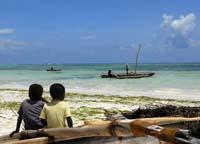 The name Zanzibar conjures up mysterious and romantic images of a palm-filled island “somewhere” far away.
The name Zanzibar conjures up mysterious and romantic images of a palm-filled island “somewhere” far away.
Zanzibar is this and more. The actual name refers to the archipelago of Indian Ocean islands off the coast of the East African nation, Tanzania. Famous through the centuries for its production of spices, the chain of islands has often been called the “Spice Islands.” Cloves, cinnamon, nutmeg and pepper are among the treasures of this place.
With two large islands, Unguja (sometimes called Zanzibar) and Pemba, with a sprinkling of smaller islands, Zanzibar begins 25 kilometers off the mainland and is 6 degrees south of the Equator. This location allows for a warm climate, soothed by ocean breezes for most of the year.
Brief History
The first residents came to the island in about AD 1000. By the 11th and 12th centuries, traders from the Persian Gulf were settling there. By 1503, the powerful Portuguese empire had established control of this lucrative spice source and they retained control for most of the following 200 years.
Zanzibar’s history includes a series of invasions. The Sultan of Oman took control in 1698 and a sad period of thriving slave trade ensued. British control was formalized in 1890 and lasted until Independence in 1963. In 1964, Zanzibar joined with the mainland, Tanganyika to form Tanzania.
Besides spices and tourism, Zanzibar also thrives from the cultivation of native Raffia palms, which are primarily used in textiles production and construction.
Tourist Destinations
It is safe to say most tourists do not make Zanzibar the sole destination of their travels. With world-class game parks providing excellent safaris in both Kenya to the northwest and Tanzania’s mainland, an excursion to the islands is a perfect way to round out your East African experience with two to four nights in the area.
Beaches
White sand and clear, warm water are typical of the tropical beaches of Zanzibar. There are about 25 different beach spots from which to choose; many are remote and very quiet. The dhow making (used for pearl diving, fishing) center for the islands is the north and the area hosts many small fishing villages. These sea-worthy vessels have been used between the islands for hundreds of years. The traditional work of fishing and building dhows provides the traveler a chance to observe local industry done in the time-honored way.
Due to the coral reef, the surf is not large around the islands. While this means people don’t come here to ride the waves, it does guarantee colorful coral life and calm waters for snorkeling and diving alike. There are beautiful stretches of beach on the western and eastern shores of the main island, all welcoming, warm and un-crowded.
Stone Town
This ancient city still pulses with life. Her busy markets (full of spice trading making the air aromatic), alley-like lanes and pretty views provide tourists with pleasant walks in a historic and culturally rich setting. Stone Town features narrow winding streets, mosques (the island is predominately Muslim), terraces, rounded towers and other hallmarks of Arabic architecture, as well as the Anglican Cathedral of Christ. The cathedral’s cross is made of the wood of the tree under which Dr. David Livingstone, who fought to suppress slavery, died. UNESCO recently named Stone Town a World Heritage Site.
The islands boast hundreds of traditionally carved wooden doors, which grace old walls and homes everywhere. These doors were once thought to reflect the economic station of the occupant and thus they developed into quite the pieces of art. Often framed in bright shades of Bougainville, a dark wood door set in whitewashed walls makes for a lovely photograph.
Other Sites
When walking through Stone Town or relaxing on beaches has satisfied you, a spice plantation tour is a nice diversion. The volume of spices produced and variety of uses from medicinal to culinary and cosmetic will surprise and delight the interested traveler while the senses are pleased.
In the Jozani Natural Forest Reserve visitors can catch a glimpse of the rare and native Red Colobus monkey. Several other species of monkey make this area home, as well as small bucks and bush pigs. The reserve offers lovely trails and well-informed guides.
Prison Island, once a holding for slaves who were being punished, provides excellent snorkeling. It also houses a family of giant tortoises that were originally brought here from the Seychelles toward the end of the 19th century.
There are daily flights to Zanzibar and ferries leaving from Dar es Salaam on a regular basis. However you chose to get there, you won’t regret a few days in this historical and relaxing tropical destination.
For more information: http://zanzibar.net
